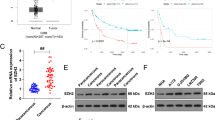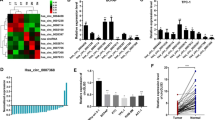Abstract
Emerging evidences have indicated that abnormal expression of microRNAs (miRNAs) contributed to carcinogenesis of ovarian cancer. However, the molecular mechanism of many aberrant expressed miRNAs was not known. Here, we discovered that miR-1224-5p was a downregulated miRNA in ovarian cancer via bioinformatic analysis and RT-qPCR. It was found that upregulation of miR-1224-5p inhibited cell proliferation and invasion ability of ovarian cancer cells. SND1, a well-characterized oncogene, was predicted as a target gene of miR-1224-5p. The western blotting, dual luciferase reporter assay, RNA-binding protein immunoprecipitation assay, and RT-qPCR demonstrated SND1 as a target gene of miR-1224-5p in ovarian cancer. MiR-1224-5p inhibited the expression of mesenchymal markers and increased the expression of epithelial markers in ovarian cancer cells via targeting SND1, indicating miR-1224-5p was involved in epithelial mesenchymal transition. The rescue assay manifested that miR-1224-5p-regulated cell proliferation and invasion mainly rely on downregulation of SND1 in ovarian cancer cells. In conclusion, our study revealed a direct regulatory association between miR-1224-5p and SND1 and their involvement in ovarian carcinogenesis.






Similar content being viewed by others
References:s
Bray F, Ferlay J, Soerjomataram I, Siegel RL, Torre LA, Jemal A. Global cancer statistics 2018: GLOBOCAN estimates of incidence and mortality worldwide for 36 cancers in 185 countries. CA Cancer J Clin. 2018;68:394–424.
Cannistra SA. Cancer of the ovary. N Engl J Med. 2004;351:2519–29.
Chen Y, Wang DD, Wu YP, et al. MDM2 promotes epithelial-mesenchymal transition and metastasis of ovarian cancer SKOV3 cells. Br J Cancer. 2017;117:1192–201.
Liang H, Yu T, Han Y, et al. LncRNA PTAR promotes EMT and invasion-metastasis in serous ovarian cancer by competitively binding miR-101-3p to regulate ZEB1 expression. Mol Cancer. 2018;17:119.
Ebrahimi S, Hashemy SI. MicroRNA-mediated redox regulation modulates therapy resistance in cancer cells: clinical perspectives. Cell Oncol (Dordr). 2019;42:131–41.
Aigner A. MicroRNAs (miRNAs) in cancer invasion and metastasis: therapeutic approaches based on metastasis-related miRNAs. J Mol Med (Berl). 2011;89:445–57.
Bhayani MK, Calin GA, Lai SY. Functional relevance of miRNA sequences in human disease. Mutat Res. 2012;731:14–9.
Das J, Podder S, Ghosh TC. Insights into the miRNA regulations in human disease genes. BMC Genomics. 2014;15:1010.
Deb B, Uddin A, Chakraborty S. miRNAs and ovarian cancer: an overview. J Cell Physiol. 2018;233:3846–54.
Wang Z, Ji G, Wu Q, et al. Integrated microarray meta-analysis identifies miRNA-27a as an oncogene in ovarian cancer by inhibiting FOXO1. Life Sci. 2018;210:263–70.
Zhang S, Zhang JY, Lu LJ, Wang CH, Wang LH. MiR-630 promotes epithelial ovarian cancer proliferation and invasion via targeting KLF6. Eur Rev Med Pharmacol Sci. 2017;21:4542–7.
Qian J, Li R, Wang YY, et al. MiR-1224-5p acts as a tumor suppressor by targeting CREB1 in malignant gliomas. Mol Cell Biochem. 2015;403:33–41.
Lian H, Xie P, Yin N, et al. Linc00460 promotes osteosarcoma progression via miR-1224-5p/FADS1 axis. Life Sci. 2019;233:116757.
Gu X, Xue J, Ai L, et al. SND1 expression in breast cancer tumors is associated with poor prognosis. Ann NY Acad Sci. 2018;1433:53–60.
Yu L, Liu X, Cui K, et al. SND1 acts downstream of TGFbeta1 and upstream of Smurf1 to promote breast cancer metastasis. Cancer Res. 2015;75:1275–86.
Wang N, Du X, Zang L, et al. Prognostic impact of Metadherin-SND1 interaction in colon cancer. Mol Biol Rep. 2012;39:10497–504.
Permuth JB, Reid B, Earp M, et al. Inherited variants affecting RNA editing may contribute to ovarian cancer susceptibility: results from a large-scale collaboration. Oncotarget. 2016;7:72381–94.
Xin L, Zhao R, Lei J, et al. SND1 acts upstream of SLUG to regulate the epithelial-mesenchymal transition (EMT) in SKOV3 cells. FASEB J. 2019;33:3795–806.
Yokoi A, Matsuzaki J, Yamamoto Y, et al. Integrated extracellular microRNA profiling for ovarian cancer screening. Nat Commun. 2018;9:4319.
Tsao SW, Mok SC, Fey EG, et al. Characterization of human ovarian surface epithelial cells immortalized by human papilloma viral oncogenes (HPV-E6E7 ORFs). Exp Cell Res. 1995;218:499–507.
Langhe R. microRNA and ovarian cancer. Adv Exp Med Biol. 2015;889:119–51.
Quitadamo A, Tian L, Hall B, Shi X. An integrated network of microRNA and gene expression in ovarian cancer. BMC Bioinform. 2015;16(Suppl 5):S5.
Teng Y, Su X, Zhang X, et al. miRNA-200a/c as potential biomarker in epithelial ovarian cancer (EOC): evidence based on miRNA meta-signature and clinical investigations. Oncotarget. 2016;7:81621–33.
Elias KM, Fendler W, Stawiski K, et al. Diagnostic potential for a serum miRNA neural network for detection of ovarian cancer. Elife. 2017;6:e28932.
Fukagawa S, Miyata K, Yotsumoto F, et al. MicroRNA-135a-3p as a promising biomarker and nucleic acid therapeutic agent for ovarian cancer. Cancer Sci. 2017;108:886–96.
Scarpati DVG, Falcetta F, Carlomagno C, et al. A specific miRNA signature correlates with complete pathological response to neoadjuvant chemoradiotherapy in locally advanced rectal cancer. Int J Radiat Oncol Biol Phys. 2012;83:1113–9.
Mosakhani N, Lahti L, Borze I, et al. MicroRNA profiling predicts survival in anti-EGFR treated chemorefractory metastatic colorectal cancer patients with wild-type KRAS and BRAF. Cancer Genet. 2012;205:545–51.
Xiong DD, Xu WQ, He RQ, Dang YW, Chen G, Luo DZ. In silico analysis identified miRNAbased therapeutic agents against glioblastoma multiforme. Oncol Rep. 2019;41:2194–208.
Wang Q, Zhang R, Liu D. Long non-coding RNA ZEB1-AS1 indicates poor prognosis and promotes melanoma progression through targeting miR-1224-5p. Exp Ther Med. 2019;17:857–62.
Wei Y, Zhang F, Zhang T, et al. LDLRAD2 overexpression predicts poor prognosis and promotes metastasis by activating Wnt/beta-catenin/EMT signaling cascade in gastric cancer. Aging (Albany NY). 2019;11:8951–68.
Thiery JP, Sleeman JP. Complex networks orchestrate epithelial-mesenchymal transitions. Nat Rev Mol Cell Biol. 2006;7:131–42.
Li H, Yu L, Liu J, et al. miR-320a functions as a suppressor for gliomas by targeting SND1 and beta-catenin, and predicts the prognosis of patients. Oncotarget. 2017;8:19723–37.
Emdad L, Janjic A, Alzubi MA, et al. Suppression of miR-184 in malignant gliomas upregulates SND1 and promotes tumor aggressiveness. Neuro Oncol. 2015;17:419–29.
Liu Z, Liang X, Li X, et al. MiRNA-21 functions in ionizing radiation-induced epithelium-to-mesenchymal transition (EMT) by downregulating PTEN. Toxicol Res (Camb). 2019;8:328–40.
Nguyen PNN, Choo KB, Huang CJ, Sugii S, Cheong SK, Kamarul T. miR-524-5p of the primate-specific C19MC miRNA cluster targets TP53IPN1- and EMT-associated genes to regulate cellular reprogramming. Stem Cell Res Ther. 2017;8:214.
Wang Y, Le Y, Xue JY, Zheng ZJ, Xue YM. Let-7d miRNA prevents TGF-beta1-induced EMT and renal fibrogenesis through regulation of HMGA2 expression. Biochem Biophys Res Commun. 2016;479:676–82.
Funding
Not applicable.
Author information
Authors and Affiliations
Contributions
JW, YH, and CY performed the experiments and analyzed the data. JW and JL collected the specimens and the information of patients. CYe and JL wrote the manuscript.
Corresponding author
Ethics declarations
Conflict of interest
The authors declare that they have no competing interests, and all authors confirmed its accuracy.
Ethics approval and consent to participate
The protocol of the present study was approved by the ethic committee of China-Japan Union Hospital of Jilin University.
Informed consent
Informed consents were provided by all participants.
Additional information
Publisher's Note
Springer Nature remains neutral with regard to jurisdictional claims in published maps and institutional affiliations.
Rights and permissions
About this article
Cite this article
Wang, J., Hu, Y., Ye, C. et al. miR-1224-5p inhibits the proliferation and invasion of ovarian cancer via targeting SND1. Human Cell 33, 780–789 (2020). https://doi.org/10.1007/s13577-020-00364-4
Received:
Accepted:
Published:
Issue Date:
DOI: https://doi.org/10.1007/s13577-020-00364-4




